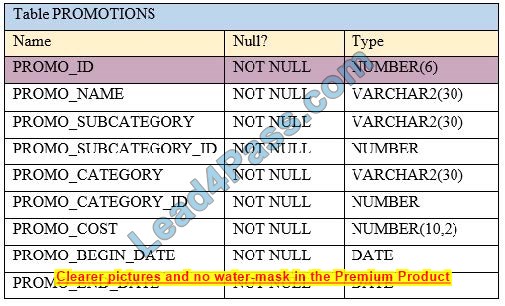Oracle Database SQL Exam Solutions: New 1z0-071 Dumps

New 1z0-071 Dumps contains 459 latest exam questions and answers, edited and reviewed by the Oracle Database SQL team, and participated in the verification of actual scenarios. It is real and effective and is the best solution for the Oracle Database SQL certification exam.
Use PDF or VCE to practice New 1z0-071 exam questions: https://www.leads4pass.com/1z0-071.html (1z0-071 Dumps), to help you test the SQL language, data modeling, and using SQL in the Oracle database Proficiency and in-depth understanding of creating and manipulating tables in!
Practice new 1z0-071 dumps exam questions online
| From | Number of exam questions | Associated certification |
| Lead4Pass | 459 Q&A | Oracle Database |
Question 1:
Which two queries execute successfully?
A. SELECT INTERVAL \’1\’ DAY – SYSDATE FROM DUAL;
B. SELECT SYSTIMESTAMP + INTERVAL \’1\’ DAY FROM DUAL;
C. SELECT INTERVAL \’1\’ DAY – INTERVAL \’1\’ MINUTE FROM DUAL;
D. select INTERVAL \’1\’ DAY +INTERVAL \’1\’ MONTH FROM DUAL;
E. SELECT SYSDATE “INTERVAL \’1\’ DAY FROM DUAL;
Correct Answer: BC
Question 2:
View the Exhibits and examine the structure of the COSTS and PROMOTIONS tables.
You want to display PROD IDS whose promotion cost is less than the highest cost PROD ID in a pro-motion time interval.
Examine this SQL statement:

Exhibit 1.

Exhibit 2.

What will be the result?
A. It executes successfully but does not give the required result.
B. It gives an error because the ALL keyword is not valid.
C. It gives an error because the GROUP BY clause is not valid
D. It executes successfully and gives the required result.
Correct Answer: A
Question 3:
Which three statements are true about the Oracle to join and ANSI Join syntax?
A. The Oracle join syntax only supports right outer joins,
B. The Oracle join syntax supports the creation of a Cartesian product of two tables.
C. The SQL:1999 compliant ANSI join syntax supports natural joins.
D. The Oracle join syntax supports natural joins.
E. The Oracle join syntax performs better than the SQL:1999 compliant ANSI join syntax.
F. The SQL:1999 compliant ANSI join syntax supports the creation of a Cartesian product of two tables.
G. The Oracle join syntax performs less well than the SQL:1999 compliant ANSI Join Answer.
Correct Answer: BCF
Question 4:
Examine the structure of the BOOKS_TRANSACTIONS table:

You want to display the member IDs, due date, and late fee as $2 for all transactions. Which SQL statement must you execute?
A. SELECT member_id AS MEMBER_ID, due_date AS DUE_DATE, $2 AS LATE_FEE FROM BOOKS_TRANSACTIONS;
B. SELECT member_id \’MEMBER ID\’, due_date \’DUE DATE\’, \’$2 AS LATE FEE\’ FROM BOOKS_TRANSACTIONS;
C. SELECT member_id AS “MEMBER ID”, due_date AS “DUE DATE”, \’$2\’ AS “LATE FEE” FROM BOOKS_TRANSACTIONS;
D. SELECT member_id AS “MEMBER ID”, due_date AS “DUE DATE”, $2 AS “LATE FEE” FROM BOOKS_TRANSACTIONS;
Correct Answer: C
Question 5:
Which two are true about a SQL statement using SET operations such as UNION?
A. The data type of each column returned by the second query must be implicitly convertible to the data type of the corresponding column returned by the first query
B. The data type of each column returned by the second query must exactly match the data type of the corresponding column returned by the first query
C. The number, but not names, of columns must be identical for all SELECT statements in the query
D. The data type group of each column returned by the second query must match the data type group of the corresponding column returned by the first query
E. The names and number of columns must be identical for all SELECT statements in the query.
Correct Answer: AC
Question 6:
Which three statements are true about performing DML operations on a view with no Instead of triggers defined?
A. WITH CHECK clause has no effect when deleting rows from the underlying table through the view.
B. Insert statements can always be done on a table through a view.
C. Views cannot be used to add rows to an underlying table if the table has columns with NOT NULL constraints lacking default values That are not referenced in the defining query of the view.
D. Views cannot be used to add or modify rows in an underlying table if the defining query of the view contains the DISTINCT keyword.
E. Delete statements can always be done on a table tough a view.
F. Views cannot be used to query rows from an underlying table if the table has a PRIMARY KEY and the PRIMARY KEY columns are not referenced in the defining query of the view.
Correct Answer: CDF
Question 7:
Which two statements will return the names of the three employees with the lowest salaries?
A. SELECT last_name, salary FROM employees WHERE ROWNUM<=3
B. SELECT last_name, salary FROM employees ORDER BY salary FETCH FIRST 3 ROWS ONLY;
C. SELECT last_name,salary FROM employees WHERE ROWNUM<=3 ORDER BY (SELECT salary FROM employees);
D. SELECT last_name,salary FROM (SELECT * FROM employees ORDER BY salary) WHERE ROWNUM <=3;
E. SELECT last_name, salary FROM employees FETCH FIRST 3 ROWS ONLY ORDER BY salary;
Correct Answer: BD
Question 8:
Which two are true about the USING clause when joining tables?
A. All column names in a USING clause must be qualified with a table name or table alias.
B. It can never be used with a natural join.
C. It is used to specify an equijoin of columns that have the same name in both tables.
D. It can never be used with a full outer join.
E. It is used to specify an explicit join condition involving operators.
Correct Answer: BE
Question 9:
Examine the description of the CUSTOMERS table:

CUSTNO is the PRIMARY KEY.
You must determine if any customers\’ details have been entered more than once using a different CUSTNO, by listing all duplicate names.
Which two methods can you use to get the required result?
A. LEFT OUTER JOIN with a self-join
B. PULL OUTER JOIN with a self-join
C. subquery
D. RIGHT OUTER JOIN with a self join
E. self Join
Correct Answer: CE
Question 10:
Examine the data in the CUST_NAME column of the CUSTOMERS table:

You want to display the CUST_NAME values where the last name starts with Mc or MC.
Which two WHERE clauses give the required result?
A. WHERE UPPER(SUBSTR(cust_name, INSTR(cust_name,\’ \’) + 1)) LIKE UPPER(\’MC%\’)
B. WHERE SUBSTR(cust_name, INSTR(cust_name,\’ \’) + 1) LIKE \’Mc%\’ OR \’MC%\’
C. WHERE INITCAP(SUBSTR(cust_name, INSTR(cust_name,\’ \’) + 1)) IN (`MC%\’,\’Mc%\’)
D. WHERE INITCAP(SUBSTR(cust_name, INSTR(cust_name,\’ \’) + 1)) LIKE `Mc%\’
E. WHERE SUBSTR(cust_name, INSTR(cust_name,\’ `) + 1) LIKE `Mc%\’
Correct Answer: AD
Question 11:
View the exhibits and examine the structures of the COSTS and PROMOTIONS tables.

Evaluate the following SQL statement:

What would be the outcome of the above SQL statement?
A. It displays prod IDs in the promo with the lowest cost.
B. It displays prod IDs in the promos with the lowest cost in the same time interval.
C. It displays prod IDs in the promos with the highest cost in the same time interval.
D. It displays prod IDs in the promos Which cost less than the highest cost in the same time interval.
Correct Answer: D
Question 12:
Examine this query:
SELECT employee_id,first_name,salary
FROM employees
WHERE hire_date>\’and1\’;
Which two methods should you use to prevent prompting for a hire date value when this query is executed?
A. Use the DEFINE command before executing the query.
B. Store the query in a script and pass the substitution value to the script when executing it.
C. Replace\’and1\’ with\’andand1\’ in the query.
D. Execute the SET VERIFY OFF command before executing the query.
E. Use the UNDEFINE command before executing the query.
F. Execute the SET VERIFY ON command before executing the query.
Correct Answer: AB
Question 13:
Examine the description of the PRODUCTS table: Which two statements execute without errors?

A. MERGE INTO new_prices n USING (SELECT * FROM products) p WHEN MATCHED THEN UPDATE SET n.price= p.cost* 01 WHEN NOT MATCHED THEN INSERT(n.prod_id, n.price) VALUES(p.prod_id, cost*.01) WHERE(p.cost<200);
B. MERGE INTO new_prices n USING (SELECT * FROM products WHERE cost>150) p ON (n.prod_id= p.prod_id) WHEN MATCHED THEN UPDATE SET n.price= p.cost*.01 DELETE WHERE (p.cost<200);
C. MERGE INTO new_prices n USING products p ON (p.prod_id =n.prod_id) WHEN NOT MATCHED THEN INSERT (n.prod _id, n.price) VALUES (p.prod_id, cost*.01) WHERE (p.cost<200);
D. MERGE INTO new_prices n USING (SELECT * FROM products WHERE cost>150) p ON (n.prod_id= p.prod_id) WHEN MATCHED THEN DELETE WHERE (p.cost<200)
Correct Answer: BC
Question 14:
Examine the description of the PROMOTIONS table:

You want to display the unique promotion costs in each promotion category. Which two queries can be used?
A. SELECT promo_cost, | pxomo_category FROM promotions ORDER BY 1;
B. SELECT promo_category, DISTINCT promo_cost PROM promotions ORDER BY 2:
C. SELECT DISTINCT promo_category ||\’has\’|| promo_cost AS COSTS FROM promotions ORDER BY 1;
D. SELECT DISTINCT promo_category, promo_cost FROM promotions ORDER BY 1;
E. SELECT DISTINCT promo_cost ||\’ in\’ II DISTINCT promo_category FROM promotions ORDER BY 1;
Correct Answer: CD
Question 15:
Which two statements are true about selecting related rows from two tables based on the entity relationship diagram (ERD)?
A. Relating data from a table with data from the same table is implemented with a self-join.
B. An inner join relates rows within the same table.
C. Rows from unrelated tables cannot be joined.
D. Implementing a relationship between two tables might require joining additional tables.
E. Every relationship between the two tables must be implemented in a Join condition.
Correct Answer: AD
…
New 1z0-071 Dumps is the best solution to ensure you successfully pass the Oracle Database SQL certification exam, by using 1z0-071 Dumps: https://www.leads4pass.com/1z0-071.html to help you practice Oracle Database SQL
All the core content of the exam (including query, insert, update and delete SQL statements and some practical knowledge of data definition language and data control language, optimizer, story and index, data modeling, and normalization.) Guaranteed to pass practical exercises and succeed Pass the exam.